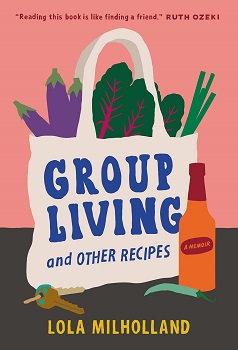Group Living and Other Recipes: A Memoir by Lola Milholland
In a time when it is rare to tune into the news without hearing a story about high housing costs or housing shortages, Lola Milholland’s debut memoir, “Group Living and Other Recipes,” is a timely examination of taking a different approach to the way we define home and family.
Although a memoir, the quirky, creative cast of characters that pass through the Milholland family’s Holman Street house in Portland make this memoir read like Armistead Maupin’s popular “Tales of the City” novels about tenants living in a San Francisco apartment complex owned by an eccentric, marijuana-growing landlady.
Milholland’s mother purchased the Holman Street house — a white, two-story craftsman in a neighborhood filled with old houses and a canopy of 100-year-old trees — in 1990 with a downpayment that came from money borrowed from her boss. Her hippie parents’ philosophy about the house was “we only deserve it if we share it,” resulting in a constant stream of visitors and unusual guests staying in the house during Milholland’s childhood.
When her parents split up and moved elsewhere, Milholland and her brother took over the house and continued this tradition, joined by several roommates — stop-motion animators and accomplished cooks — whose love of food, cooking and shared meals is the axis around which the household orbits. Roommate Chris delights in cooking Northern Thai foods from his childhood and many of these mouth-watering recipes are included.
Milholland muses that she came to recognize Holman House as being like having another roommate, as it seemed to demand attention like a “romantic who keeps marrying and remarrying, getting back together with exes, falling in love again.”
While the inclusion of recipes makes this book feel like a food memoir and the ups and downs of life in the house read like character-driven fiction, the parts of the book that explore alternate ways of sharing space together ask thoughtful questions that feel very relevant to now. For example, Milholland found that intentional communities don’t inherently create camaraderie and intimacy but that something less structured yet not so atomized as the nuclear family can create these qualities.
She is intrigued by the theory of idiorrhythmy found in the monastic tradition and providing both isolation and contact, something like “solitude with regular interruptions.” She spends time considering housing coops and cites one ecovillage that added a space where someone could lease rather than buy land and build a tiny house on the leased land, bridging ownership and rental.
In the fall, Milholland forages for matsutake, chanterelle, morel and porcini mushrooms, and reflects that their mycorrhizal symbiotic interdependence with trees can be similar to group living dynamics where, through giving and receiving, a group of people cohabitating can become like one organism.
In summary, Milholland’s guidance for group living means embracing contradictions: freedom and structure, being together and being alone, power and surrender, vulnerability and strength. Both entertaining and thought-provoking, this memoir is a good jump-off point for discussion on the topic of how we choose to live and provides a vision of one possibility.
Lisa Gresham is the collection services manager for the Whatcom County Library System, wcls.org.
(Originally published in Cascadia Daily News, Monday, September 16, 2024.)

